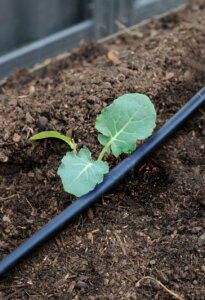BROCCOLI
- Scientific name: Brassica oleracea var. italica, of the Brassicaceae family, cultivated as an annual plant.
- Broccoli originated in Italy, where it owes its name, from the wild cabbage with continuous natural evolution of the plant’s flower buds for about 2,000 years.
- Global broccoli production (together with cauliflower) according to FAO reached 26.9 million tons in 2019. China is the largest producing country, followed by India, while together they have almost 73% of global production. These two are followed by countries with significantly lower production, such as the United States of America, Spain and Mexico.
- Raw broccoli consists of water (89%), carbohydrates (7%), protein (3%) and an insignificant amount of fat. It is a rich source of fibre (about 20% of the required daily intake) as well as many vitamins, some in very high amounts, such as vitamin C at 107% of the required daily intake, vitamin K (97%) and vitamin B (19%). Also contained in broccoli is the substance glucoraphanin, which in the human body with the help of a specific enzyme is broken down into an active compound with proven anti-cancer activity. Finally, broccoli is rich in folic acid, magnesium and selenium and contains carotenoid lutein.
- Broccoli is actually grown for its flower heads, as this part of the plant and while it is immature is edible and rich in beneficial ingredients. It can be planted in 2 periods, Spring (for cold regions) and Autumn (for warm regions), while for the majority of its commercial varieties harvesting is from 60 to 110 days after transplanting. It is generally a cold season vegetable, as temperatures above 20°C cause the plant to start forming leafy flower heads, while temperatures above 26°C intensify the flowering of the heads, thus reducing their quality and commercial value.
IRRIGATION OF BROCCOLI
 Broccoli in general is not drought tolerant, and under conditions of poor water supply the quality of the final product deteriorates significantly, which is why irrigation is continued (depending on the conditions) even during Winter. However, caution is required, as excessive water in the roots can lead to a complete collapse of the plants even within 2-3 days, leading to significant loss in productivity.
Broccoli in general is not drought tolerant, and under conditions of poor water supply the quality of the final product deteriorates significantly, which is why irrigation is continued (depending on the conditions) even during Winter. However, caution is required, as excessive water in the roots can lead to a complete collapse of the plants even within 2-3 days, leading to significant loss in productivity.- Critical periods for broccoli irrigation are during the first stage (seed germination) and during the formation of the flower heads. It is generally recommended to provide small amounts of water in the early stages with a gradual increase as the plant grows. In any case, water requirements may vary depending on weather and soil conditions, while even broccoli varieties may also have different water requirements.
- The most common irrigation system in broccoli cultivation is drip irrigation, but sprayers can also be used under suitable conditions.
Palaplast has a wide range of products that can be used to install a reliable and efficient irrigation system whatever the method of irrigating broccoli:
- Pressure Compensating Driplines, Driplines (Paladrip – Palaplast, Paladrip-XL – Palaplast, Paladrip-Slim – Palaplast)
- Dripline fittings
- Drip Tape
- Drip Tape fittings
- Filters
Irrigation option using micro-sprinklers:
- Omega Microsprinklers [Jet, C Jet, Silicon SL Jet]
- PVC Ø12 Pipe (complete)
- Spike
And if irrigation using impact sprinklers is chosen:
- Impact Sprinklers (1/2”) [APOLLON SUPER, AKTOR, PEGASUS SUPER, IKAROS SUPER]
- Impact Sprinklers (1”) [ERMIS, ATLAS, TITAN]
- Stands
- Spike for Sprinklers (1/2”)



